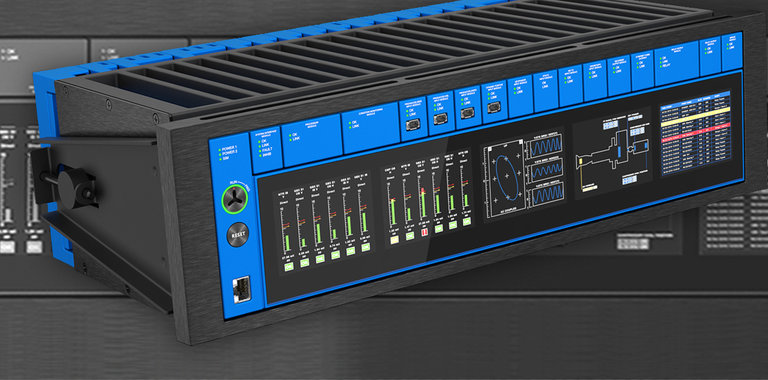
Orbit 60 Series Update: Now – Less Spares!! – How to Choose Input Modules
Introduction
Welcome back for the 3rd quarter update of Orbit 60, Bently Nevada’s latest condition monitoring, protection and data integration platform. In April, Bently Nevada announced our ability to start quoting Orbit 60 systems and we are now working with hundreds of customers globally to develop proposals for new projects, retrofits and to apply Orbit 60 to unique applications. We are actively beta testing the platform with several customers internationally and continue to be on schedule for a April 30, 2021 available to ship (ATS) commitment.
Now that you are interested in the new Orbit 60 platform, the next step is to familiarize you with the changes that this new architecture brings. This is the first in a series of planned articles to help you understand how our engineers have developed the most advanced condition monitoring and machinery protection system in the market to be easier, and less expensive for you to install and maintain. This article focuses on the Sensor Input modules, where we have reduced the number of input module types from in excess of 80 in the 3500 product family to just ten in Orbit 60. Including a New Positive Voltage input card, which provides expanded measurement capabilities. Additionally, it is typical for a 3500 installation to have many unused channels as each monitor card is designed for a specific function. Orbit 60’s architecture allows our customers more flexibility in utilizing all of the channels on a specific card. In this article, we will show how this redesign will allow you to reduce your spare parts count by up to 50%.
No need to retrofit your sensors!
One of the first questions customers ask, is “Will I need to change my transducers?” The simple, and complete answer is “No.” At Bently Nevada, we design our products to be as backwards compatible as possible. This means that if you are planning a monitoring system retrofit, Orbit 60 is designed to work with your existing architecture and sensor suite.
New measurement inputs
Orbit 60 has been able to expand our plant wide capabilities by bringing in positively biased transducers including IEPE accelerometers. This ability expands our transducer input capabilities to include those sensors that are most popular with Rolling Element Bearing, REB, monitoring. While we will cover this exciting development in depth in later articles, it should be noted here.
Reduced number of spares and associated costs
In the 3500 system, each monitor card had its own set of compatible inputs, as well as its own specific monitoring function. For example if you wanted to use a proximity probe to measure rod position on a reciprocating compressor. You would use a 3500/72 card – not the 3500/40 or 3500/42. Although both the 3500/40 or 3500/42 cards can take in a proximity probes, neither of them has the capability to give you a rod position measurement. The 3500 system was designed to have individual modules that were fit for purpose, whereas Orbit 60 is taking a universal input approach, where reciprocating compressors and turbo machinery will all share the same input cards and the same processor. This approach uses firmware on the input modules to digitize the analog signals coming from the sensors, and then putting the digital information on the Orbit 60’s data bus for analysis by the processor.
In the Orbit 60, the Protection Processing Module, PPM serves as the computational engine for the system, extracting all of the machinery measurements, as well as performing all of the alarm determinations. Therefore, it acts like the individual 3500 monitor cards, but in one centralized location, regardless of the number of input modules.
Central processing is one of the largest architectural changes that we have implemented in the Orbit 60 design. Now, instead of requiring a separate processor for each function, we have consolidated all of that functionality into one module. Although this article is not focused on the PPM, we would like you to know that while the system is SIL compliant with only one PPM, we recommend having at least two PPM modules in the system if you will be using your system for protection.
On average, our customers are achieving up to 50% reduction in spare parts with the innovative design of Orbit 60.
First, let’s discuss Keyphasors®…
I started my career at Bently Nevada in the Machinery Diagnostic Services group. It was there that I learned the importance of having a Keyphasor®. In the 3500 system, we were of course limited to having only four Keyphasors® per rack. In Orbit 60, there are no such limits, and it gets even better. Any of Orbit 60’s input modules that can accept a proximity probe, can use that proximity probe as a Keyphasor signal. For greater phase and speed accuracy Bently Nevada recommends the use of the High Speed Keyphasor module on rotors operating greater than 17,000 RPM. To minimize unused channels in the system the High Speed Keyphasor card can also accept 3 wire accels, proximitors, and Magnetic Pickups for other non-speed related applications.
Now, let’s look at the Input Cards themselves…
The first four cards that we will discuss (PAV, PAS, PAA, HS KPH) all accept negatively biased 3 wire sensors, including Proximity Sensors (including Keyphasors®) and Accelerometers. Each module then handles a specific set of 2 wire sensors including Magnetic Pickups, velomitors, and seismoprobes.
The flexible PAV input module is expected to support 90% of all vibration inputs into the Orbit 60 platform, simplifying spare parts and allowing input modules to be ordered early in the design stage without risk.
New to Orbit 60 is the PVT module, which supports a wide range of 3 wire positive voltage and 2 wire constant current sensors.
4 Channel Input Cards:
- The Proximity, Acceleration, Velomitor, PAV card can also take in measurements from 2 wire velomitors, and 2 wire negatively biased IEPE Accels.
- The Proximity, Acceleration, Seismic, PAS card can also take in moving coil seismic sensors.
- For our Aeroderivative users and any application that requires differential input measurements, we are offering the Proximity, Accelerometer, Aero, PAA card. This card can also take input from acceleration interface modules.
- The High Speed Keyphasor input card also accepts the negatively biased three wire accels and proximity sensors along with magnetic pickups.
- The Proximity, Acceleration, DC LVDT card, PAD includes the ability to connect to a DC LVDT as well as the above mentioned negatively biased 3 wire Proximity, and accelerometers.
- Our Positive Voltage Transducer Input, PVT, allows us to take in positive voltage dynamic signals natively for the first time. It will take in positively biased 3 wire accelerometers and proximity probes as well as the very popular 2 wire IEPE accelerometers.
- The AC LVDT Input includes up to four channels of 5 or 6 wire AC LVDTs
6 Channel Input Cards:
- The RTD/TC card accepts type J, K, E & T non-isolated thermocouples and 3 wire RTDs
- The Isolated TC card accepts type J, K, E & T isolated thermocouples
- Finally, the Isolated Discrete Input/Process Variable card can accept 4-20 mA, -10V to +10 V and Dry/Wet contacts
As you can see, there is a great breadth of sensors that we can bring in to the Orbit 60 platform, but, with the design of the PPM, the need for multiple input cards has been eliminated. Reduction of spares was a key design focus of the Orbit 60 architecture, allowing customers to simplify the ordering process and reduce spare parts in the stockroom.
Designed for the future……
As noted earlier, the Input modules use firmware to digitize the analog transducer signals. As we continue to develop the Orbit 60, we will also continue to unlock greater functionality with firmware updates*. These firmware updates are available through our Bently Nevada Tech Support Portal. The firmware will be released as part of each major release, which is currently scheduled to occur, annually.
* Orbit 60 will have full 3500 turbomachinery functionality or greater at release 1
More information is available on our website:
Next Steps
Our teams are excited to discuss Orbit 60 in more detail and we have multiple technical white papers available for a deeper dive into the following topics. Please reach out through the 'Orbit 60 Request Form', linked below, to receive a copy and we will connect you with your local expert.
- Orbit 60 Series or 3500 Detailed Comparison - This document details the difference between Bently Nevada’s Orbit 60 Series machinery protection system and the 3500 system.
- Orbit 60 Data Security Condition Monitoring Module - This document is intended to describe how the Condition Monitoring Module in the Orbit 60 Series Monitoring System provides a secure solution with full high-resolution data to external networks without jeopardizing the operation of the protection functions.
- Orbit 60 Series Bridging Concepts - Bently Nevada introduces the concept of bridging with the Orbit 60 Series system architecture.

Tarannum Sarang
Senior Product Manager

John Kingham
Strategic Field Application Engineer
BIO
Mr. Kingham has been involved in the rotating machinery realm for more than 35 years. He started with Bently Nevada in 1986 as a Machinery Diagnostics Engineer, where he diagnosed machinery problems based upon their vibration characteristics.





